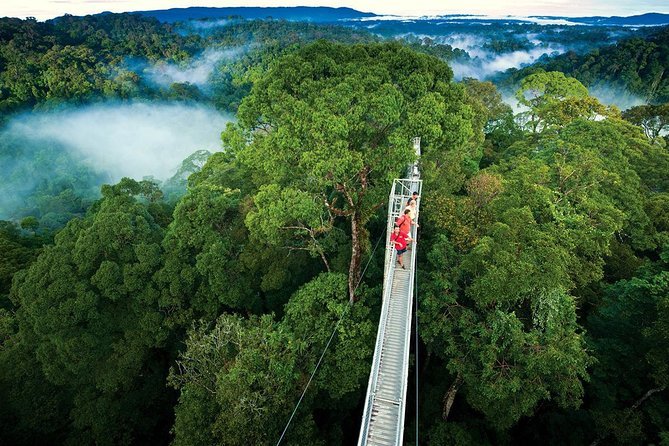The Monteverde Cloud Forest is one of the most famous and biodiverse protected areas in the world. Located in the central highlands of Costa Rica, this forest is renowned for its incredible biodiversity, lush greenery, and unique cloud forest ecosystem. Covering an area of around 26,000 acres (10,000 hectares), it straddles the Cordillera de Tilarán mountain range and is part of the larger Monteverde Conservation Area. The forest’s lush, mist-covered environment is a haven for thousands of plant, animal, and bird species, many of which are endemic to the region.

Geography and Climate
Monteverde is situated at an altitude of 1,440 meters (4,700 feet) above sea level, which results in a cool, cloudy climate with temperatures ranging from 15°C to 25°C (59°F to 77°F) year-round. The cloud forest’s high elevation, combined with its proximity to the Pacific Ocean and the Caribbean Sea, creates a unique weather pattern where moisture from the oceans condenses as mist or cloud cover, enveloping the forest throughout much of the year.
The park experiences a rainy season from May to October, with heavier rains typically falling in the afternoon and evening. The dry season lasts from November to April, although even during this time, the forest remains misty and humid. The consistently high levels of humidity and moisture support the unique vegetation and ecological systems found in the forest.
Flora and Fauna
The Monteverde Cloud Forest is incredibly rich in biodiversity, with a vast array of plant, animal, and insect species. The forest is divided into several distinct habitats, including lower montane and upper montane cloud forest, which provide a variety of ecological niches for species to thrive.
Flora:
- Epiphytes: The cloud forest is famous for its abundant epiphytes—plants that grow on other plants, often on the trunks and branches of trees. These include mosses, ferns, and orchids, which thrive in the high humidity. The park is home to over 500 species of orchids, many of which are endemic to Costa Rica and the cloud forest environment.
- Giant Trees: Tall trees, such as the Strangler Fig, Cecropia, and the Higuerón (Ficus tree), are common in Monteverde, and their dense canopies provide shelter and sustenance for many species. These trees are often covered in mosses and lichens, which thrive in the cool, moist environment.
- Cloud Forest Vegetation: The park is home to a variety of plant life, including bamboo, palms, and flowers like the passionflower and heliconia. These plants are adapted to the cloud forest’s cool, moist conditions and contribute to the incredible diversity of the area.
Fauna:
Monteverde is a wildlife haven, with hundreds of animal species living within its misty forest, including mammals, birds, amphibians, reptiles, and insects.
- Birds: Monteverde is best known for its birdwatching opportunities, particularly the iconic Resplendent Quetzal. The quetzal, with its striking green and red feathers and long tail feathers, is a symbol of Central American wildlife. The park also hosts hummingbirds, including the Violet Sabrewing and Purple-throated Mountain-gem, as well as toucanets, woodpeckers, and trogons.
- Mammals: Some of the mammals that inhabit Monteverde include howler monkeys, capuchin monkeys, coatis, agoutis, and the elusive ocelot. The cloud forest’s dense canopy provides ample shelter for these species, and many of them are nocturnal or elusive, making them difficult to spot.
- Amphibians: The forest is home to several species of frogs and toads, including the iconic red-eyed tree frog, whose bright green body and red eyes make it one of the most photographed species in the area. Other amphibians include Glass Frogs, which have transparent skin, and poison dart frogs.
- Reptiles and Insects: The cloud forest is also home to various reptiles like geckos, snakes (including the eyelash viper), and lizards. The dense vegetation supports an abundance of insects, including butterflies, moths, and beetles, many of which play crucial roles in pollination and the food chain.
Activities and Attractions
Monteverde offers visitors a wide variety of activities that allow them to experience the natural beauty of the cloud forest up close. From hiking trails to wildlife watching, the park provides numerous opportunities to explore its rich biodiversity.
Hiking and Trails:
The Monteverde Cloud Forest is home to several well-maintained trails that wind through the forest, offering visitors the chance to explore diverse ecosystems and observe wildlife. Some popular trails include:
- Sendero Bosque Nuboso (Cloud Forest Trail): A relatively short and easy trail that takes visitors through a variety of habitats, offering views of the cloud forest’s flora and fauna.
- Sendero La Ventana (The Window Trail): A more challenging trail that leads to a scenic viewpoint with breathtaking views of the surrounding landscape.
- Sendero El Camino (The Path Trail): A moderately difficult trail that crosses through different forest types, with ample opportunities for birdwatching and observing wildlife.
Canopy Tours and Hanging Bridges:
Monteverde is famous for its canopy tours, which allow visitors to experience the forest from above. One of the most popular activities is the Sky Walk, a series of hanging bridges that offer panoramic views of the forest canopy and the valley below. Walking through these suspended bridges gives visitors the opportunity to spot wildlife that lives in the higher reaches of the forest.
Night Tours:
The Monteverde Cloud Forest is home to many nocturnal species that are difficult to see during the day. Night tours led by experienced naturalist guides are a great way to observe species like bats, moths, and night-jumping frogs, as well as the sounds of the forest at night.
Birdwatching:
Monteverde is a world-renowned destination for birdwatching, particularly for enthusiasts hoping to catch sight of the Resplendent Quetzal. The park’s diverse ecosystems and various altitudes provide habitats for more than 400 bird species, making it one of the best birding locations in the world.
Butterfly Garden and Insect Exhibits:
The park is home to several educational centers, including The Butterfly Garden, where visitors can learn about the various butterfly species that thrive in the cloud forest. The center features a variety of exhibits that focus on the importance of insects and pollinators in the ecosystem.
